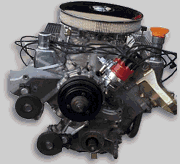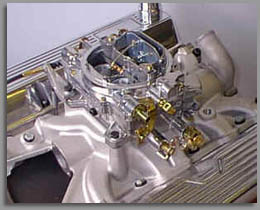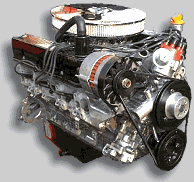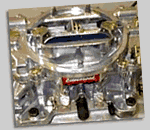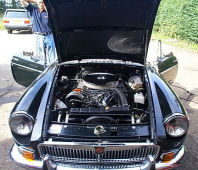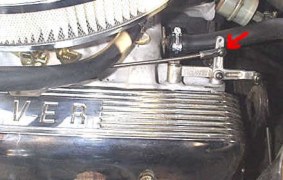
. When considering this comprehensive 'RPI / Weber Kit price'. please also
consider, that we include all the parts you need to ensure the installation is
complete. And all the information you need. Further advice & support is available on our V8 information pages and via our excellent E-mail support.
When our buying power increases, we pass on the savings to you. The Weber system offers the ultimate carburettor option for all Rover V8 engines, from 3.5 to 4.8 Litre, I would not choose or recommend any other 'medium priced' carburettor option for the non-injected Rover V8 Engine as a result of our continuing satisfaction with the Weber 500 carburettor system.
This Weber / Edelbrock Carburetion set up is suitable for all V8s and adds not
only Increased horse power, torque and efficiency but looks good adorning the
bonnet compartment of any Classic V8 Kit Car or Range / Land Rover Etc.
| Installation and set up
details |

Problems with Setting up
Q. I'm trying to fit the carburettor to the manifold but have only got THREE bolts and there are FOUR places to fit bolts, am I missing a Bolt?
A. No The kit comes with THREE bolts because the Throttle cable goes in the FOURTH bolt hole.
Full Component list
Ease of fitting and trouble free maintenance
Although being very simple to install, and just as simple for setting up on almost all engine capacities, it just simply delivers the goods without the problems of other systems. The Weber can be easily optimized to your individual requirements, even for fine tuning. The metering jets can be changed very easily as they are located just beneath the air cleaner element, and all changes can be made in seconds rather than hours. But most importantly, with no fuel spillage causing a possible fire risk and damage to your engines paint and appearance.
Limited V8. carburettor Options
The only affordable upgrade carb option has been for many years the Holley 390cfm. This carburettor has been used on all capacity Rover V8s, and with fine tuning can provide good fueling and power for the V8 engine up to 3.9 Litre.
However, the problems have always been that it is too large (390cfm) for part throttle economy/torque, and too small for more serious top end power gains, especially on larger capacity Engines. So unless you are into drag racing our advice would be to forget it.
It's better Off Road
Unlike the Weber the Holley float bowls are mounted both in front and behind the carburettor, causing fuel starvation and fuel flooding problems when off roading on steeper inclines. The Weber's float bowls are either side of the carburettor, completely alleviating the problem.
We have already done a great deal of competition & off-Roading (trailing) with the Weber and have found no fuel starvation or flooding problems when operating on steep inclines or with fast cornering.
Ease of Jetting and set up
To re-jet the Holley (Normally essential) it is required to remove the primary & secondary float bowls (plus two hours removing the glued on gaskets) and another two mopping up all the petrol that has spilled onto the intake manifold (does wonders for new paintwork). The primary side is easy enough to re-jet, but in most cases is fine as standard. However, to re-jet the secondaries, it is first necessary to purchase a 'Metering Plate' which replaces the standard item between the carb and secondary float chamber and allows the fitting of various jet sizes. Because the Holley is vacuum-only secondary activation, a great deal of fuel is wasted in high-load driving situations, where engine vacuum would activate the secondaries even though not required.
The Weber overcomes this problem by making the secondaries both vacuum and mechanically operated This means that if your foot is not on the floor, you wont be wasting fuel or engine power, in fact the torque gains on part throttle with the Weber carburettor are quite amazing, as is the cruise fuel economy. When set up properly it is not unusual for this system to surpass that of Fuel Injection, and it's certainly a lot less trouble.
Correct Jetting (it's so simple)
The Weber 500 can be re-jetted in minutes through the top. It has an adjustable power valve so no need to buy up-rated ones. It can use the same manifolds, filters and linkages as your existing Holley. You will never regret the upgrade (or your money back).
Although we will advise that the Weber 4-barrel can be used on almost any capacity without changing its basic set up, it is always possible to further improve things, although this only becomes more sensible on Engines above 3.9 lit. capacity. However, again, don't panic, because chances are we know just the jet that is best for your bigger engine first time.
Why the need for an additional Thermostat housing?
The re-use of the std thermostat housing does not allow the water pipe from the rear of the water pump to enter the intake manifold (on some original Rover intakes it appears to go underneath but it actually opens up into the manifold in the centre - different models can vary). Rover have always had this water bypass, which allows a smaller quantity of water to circulate even when the thermostat is closed. The Kit as supplied by Weber merely blanks off the pipe and does not allow this method. However, if we supply you with our special thermostat housing, this has the correct hose connection to pass water into the Edelbrock intake manifold and is correct for its original design.
Is the Weber better than twin Carbs?
Twin 'SU' and 'Stromberg' Carb System are becoming very difficult to supply or recondition effectively due to them becoming more of a Classic method of fuelling, and
they are no longer produced for production vehicles.
Indeed the best carb on the market is the Weber 4-barrel. This system has been used by us for many years now. Economy is vastly improved whilst dramatically increasing engine torque and efficiency, the net gains can be as much as 30bhp. But most noticeable is the instant throttle response that is otherwise lacking in twin carb systems.
|











